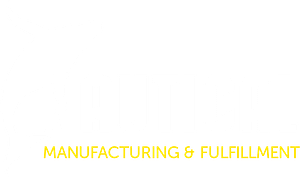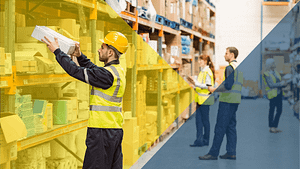What is Order Fulfillment?
Steps to Order Fulfillment Process
Order fulfillment is typically described as a series of five steps. These steps are generally consistent across fulfillment methods—the only differences being the players performing the steps, depending on the method chosen.
1. Receiving Inventory: Goods can be sent from third-party manufacturers or distributors, internal sources—or anywhere in the world— so it is crucial to carefully inspect, count, and inventory when they arrive for quality control. Stock keeping units (SKUs) or barcodes are used to organize incoming products and ensure their smooth retrieval later when orders are processed
2. Storing Inventory: After the products have been sorted and inspected, they are now ready to move into their respective storage areas. There are two main storage areas: short-term and long-term storage areas. The short-term storage area is typically used to hold items briefly for existing orders. Long-term storage is typically used for surplus inventory based on forecast demand; by keeping enough goods on hand a company can avoid the risk of shortages and delayed shipments. A business may choose to conduct an additional inspection of these items before sending them to the customers.
3. Processing and Picking Orders: Once a customer places an order, it’s time to retrieve items from storage and prepare them for shipment. Warehouse staff or an automated warehouse picking system will check the order details and pick the correct items for shipment. A packing slip is generated along with the order and includes item SKUs, item locations, item quantity, and other product variations to assist with the picking process.
4. Packing the Order: Packing includes conducting any final inspections of the products included for shipment, as well as selecting appropriate packaging materials for the order. Delivery costs are often a significant cost to a company, so selecting the correct packaging materials to achieve the optimal dimensional weight in a shipping box is a critical component of order packing. Depending on the fragility and size of the products, appropriate packaging must be selected to mitigate the risk of damage during the delivery process.
5. Shipping and Returns: There are many carriers (like FedEx, UPS, or USPS) that can be considered for order delivery, and shipping routes will often include more than one carrier. A 3PL partner may also provide its own delivery. Each carrier has its own packaging requirements and shipping costs based on a package’s weight and dimensions. Delivery occurs when the goods are deposited at the customer’s chosen location. It also includes sending shipping confirmation to the shopper’s email (or an update to a B2B customer) to inform them about their incoming package, and a notification upon the good’s arrival.
Returns processing happens when a customer isn’t satisfied with an order (or wishes to return a product for any other valid reason). It entails generating a return label for the customer so they can easily send the package back to the seller. From there, the seller needs a procedure in place for cleaning, sorting, and restocking the product and issuing a refund to the customer.
Common Models of Order Fulfillment
Order fulfillment roles have changed over the decades to meet shifting consumer demand, but the actions involved in fulfilling orders have largely remained the same. Here are the four main methods that companies use today:
Dropshipping
In dropshipping, a supplier or manufacturer runs the order fulfillment process on behalf of an online retailer. This method is great for small businesses, or those with exclusively online storefronts, as these companies don’t need to spend capital on warehouses or labor to fulfill orders. However, because of thin margins and the lack of control inherent in this method, it may not be optimal for some businesses.
Pros:
- Very low startup costs
- Gives time to focus on other business areas
Cons:
- Little communication with your supplier
- Products won’t be customized to your brand
Third-Party Fulfillment
Like dropshipping, third-party fulfillment involves outsourcing the order fulfillment process to a 3PL (third party logistics provider). Unlike dropshipping, the 3PL focuses exclusively on packaging and shipping–not on manufacturing. Because it specializes in these areas, a 3PL can often help a business partner achieve better rates on packaging and shipping. 3PL providers also offer other value-added services like kitting, personalization, and other benefits to enhance customer experience.
Pros:
- Fast fulfillment speeds
- Ability to scale order volume easily
- Lower shipping rates
Cons:
- Less control of your products and how they are fulfilled
In-House Fulfillment
In-house fulfillment or self-fulfillment is exactly what it sounds like—in it, the company chooses to manage all aspects of order fulfillment on its own. This offers more control over the quality of products, branding, and the packaging of orders. In-house fulfillment can be challenging for businesses with fewer resources because it requires significant storage space, labor, and capital costs.
Pros:
- Focus on quality and customer experience
- No fulfillment fees
Cons:
- Diverts resources from other value-driving operations
- Shipping costs will be higher than working with an experienced 3PL provider
Hybrid Fulfillment
The most diverse of the fulfillment models, hybrid fulfillment uses a combination of all three of the above fulfillment types. This allows a company to be extremely flexible and leverage the optimal fulfillment approach based on the situation. While it can be a highly cost-effective approach, due to the complexity of its many moving parts, it’s crucial for a business to consider the additional stress this method will place on its operations.
Pros:
- Ability to offer multiple fulfillment options
- Creates a more adaptive supply chain
Cons:
- Very complex to manage
- Can result in inconsistent customer experiences
Choosing the Right Order Fulfillment Method For Your Company
Due to the significant advantages that accompany a partnership with a supply chain provider, it’s likely that your company will want to consider outsourcing order fulfillment operations. If you do, be sure to evaluate which provider will fit your business best. Here are some factors that you should consider:
Experience: You should look for a provider who has experience with companies that have a similar set of needs to your business. A provider should be familiar and comfortable handling the types and configurations of products that you sell.
Cost: Cost is one of the most important factors for any business decision—and choosing a fulfillment provider is no exception. Make sure you choose a provider that allows you to add value to your business and your customers.
Technology: As technology advances, costs will adjust to meet shifts that happen in the supply chain landscape, so consider your provider’s technology capabilities to ensure a long-term arrangement (if that’s what your business needs) will be possible. Make sure they have equipment and technology that will allow them to scale with your business.
Location: Research provider warehouses and distribution centers to ensure they can provide fast shipping to the majority of your customers. Access to anywhere in the country is typically preferred.
Customer Service: There will be times when there are issues with the fulfillment process, so it’s crucial to select a partner with excellent support in place. A provider should consider itself a partner to your business, and be dedicated to managing issues and helping moderate the ebb and flow of your business needs.
Outsource Your Fulfillment With Nautical
If you are considering third-party fulfillment for your business, Nautical Manufacturing and Fulfillment is a great choice. As a centrally located 3PL in Kansas City, we provide efficient and cost-effective fulfillment services to businesses of all sizes. At Nautical, our fulfillment experts work closely with you to understand your business requirements and provide all the value-added fulfillment services you may need. From receiving and inventory management to pick & pack and delivery, Nautical has you covered.




